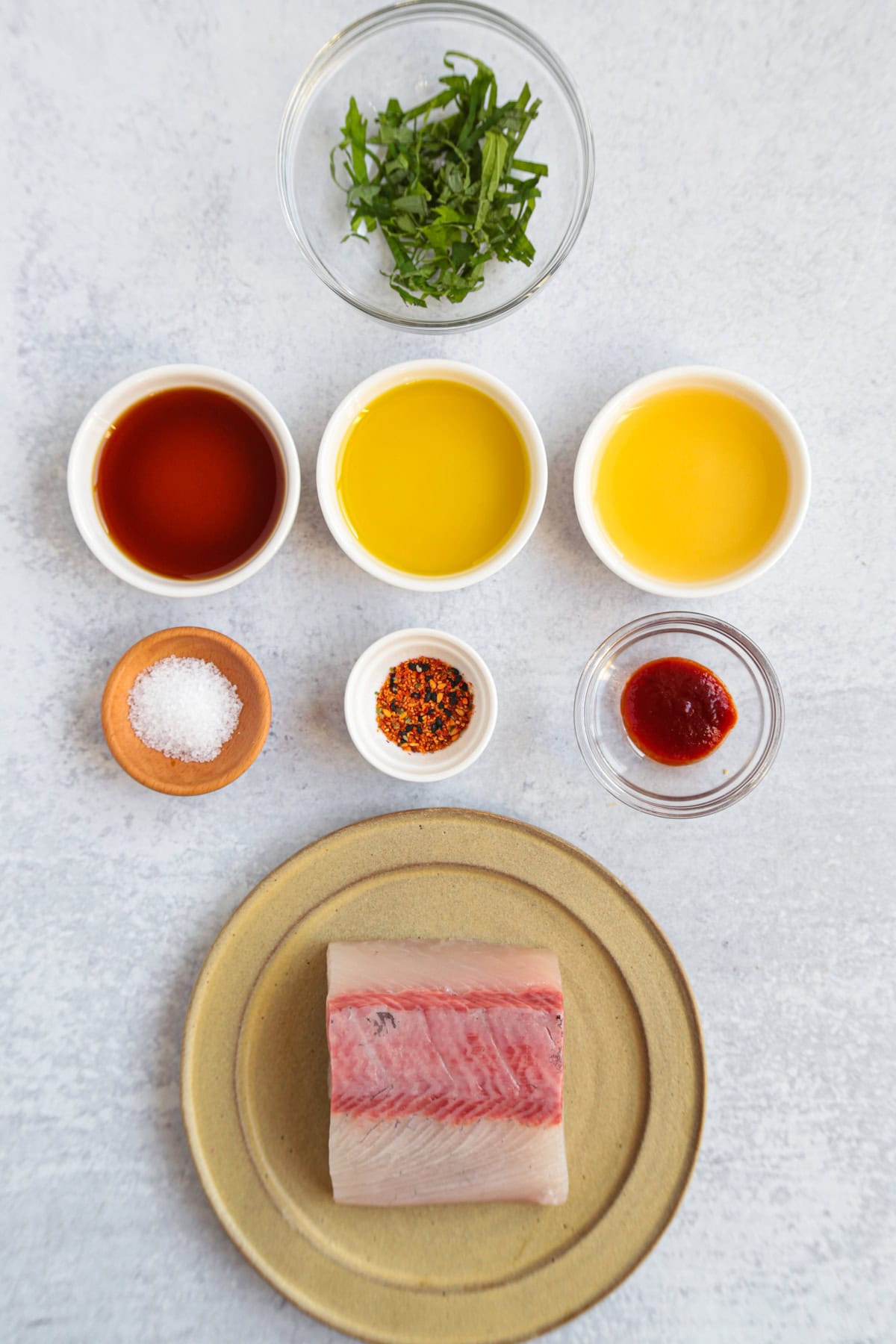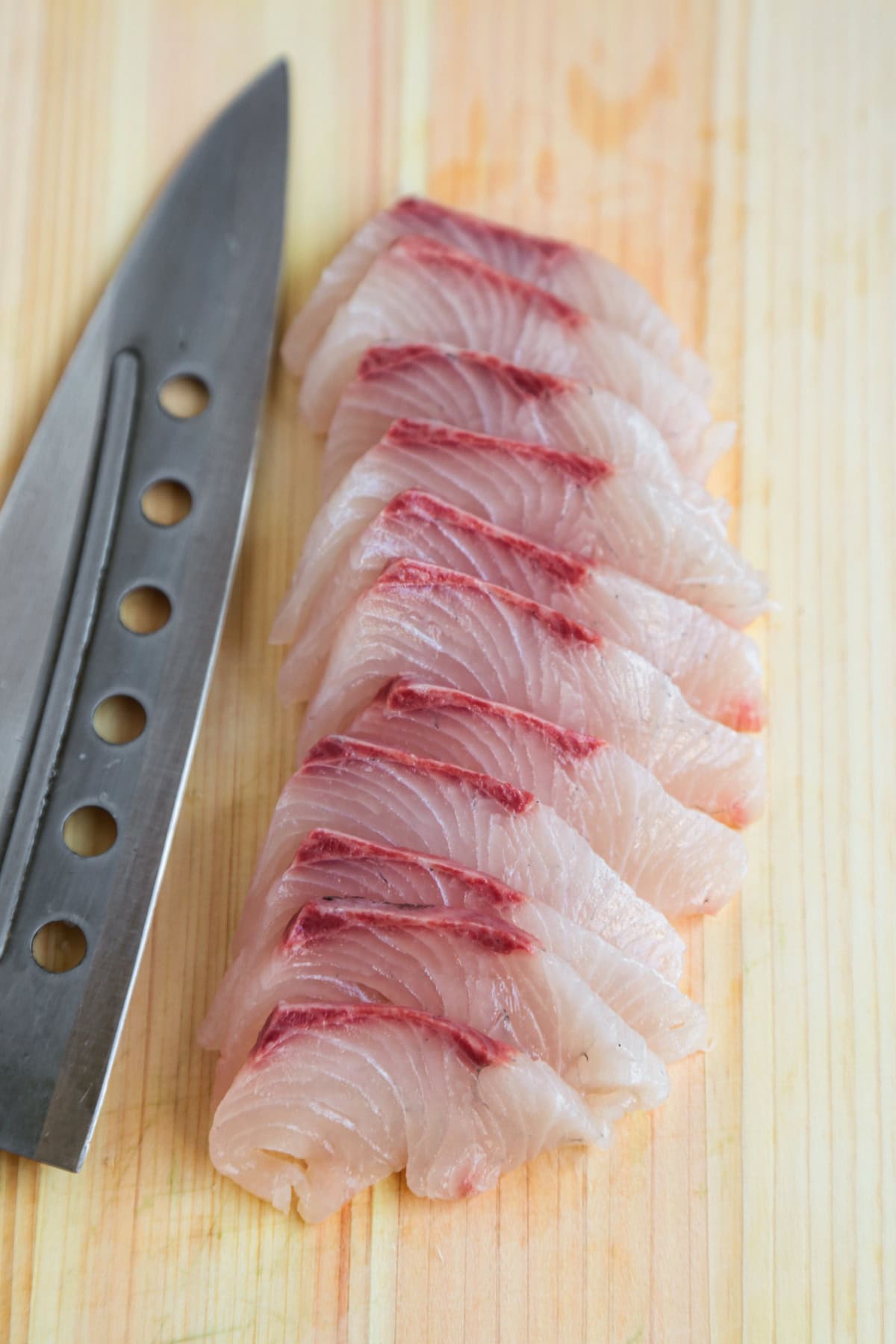Making hamachi crudo at home is very easy and costs significantly less than ordering it at a fancy 4-star restaurant. The dish only takes about 15 minutes to make and the list of ingredients is short. Once you learn how to make it at home you will never order it from a menu again!

About This Recipe
Hamachi crudo is a simple dish consisting of cold raw sliced yellowtail topped with various toppings and a refreshing citrus and soy sauce dressing. It’s served as an appetizer and has a buttery, savory, citrusey, and slight fruity taste. It’s one of my favorite appetizers of all time because of its light and refreshing properties. My recipe is quick and only requires 8 ingredients.
I took to making hamachi crudo at home when I lived in New York City as it was easier to shop for Japanese ingredients (before Amazon sold groceries). The first time I made it I was nervous because I didn’t know much about how to handle raw fish. I was scared that Ben and I would end up with food poisoning. Everything went well and the dish was delicious! And the more I read about it, the more comfortable I became with making things like hamachi crudo, tekka don and scallop crudo at home.
Table of contents

Ingredients Needed
- Ponzu sauce: Ponzu sauce is a popular Japanese sauce made of yuzu, a fruit that tastes somewhere between an orange and a lemon, mixed with soy sauce. It’s often used as a dipping sauce, salad dressing, with sashimi, or added to sauces to deepen the flavor. If you cannot find ponzu sauce, I have a quick recipe that’s easy to make.
- Lime: For this recipe I recommend using fresh lime juice over store bought lime juice since the dish is delicate and light. Fresh lime juice is sweeter and tastes less acidic than the bottled type.
- Hot sauce: There are two hot sauces that can be used: sriracha sauce or sambal oelek (Indonesian chili paste). That’s because these two sauce aren’t sweet and not too vinegary. Something like Frank’s red hot sauce or a barbecue flavored hot sauce will overpower the other flavors, making it hard to taste the delicate buttery taste of yellowtail or amberjack.
- Sashimi grade yellowtail or amberjack: Both fish can be used as the flavor and texture are similar. Make sure it says sashimi-grade on the package for safety and freshness. Or, buy it at your local fishmonger to ensure that you are getting the freshest and best fish.
- Shiso leaf: Shiso leaves have a very unique flavor that’s hard to replicate. It’s a little minty, lemony, anise-like, and basil-like. If you cannot find it, use basil or cilantro.
- Olive oil: Only use high quality olive oil when making a crudo! That’s because high quality olive oil has a stronger, fruitier taste that’s full of aromatics. A cheap olive oil doesn’t have much flavor or any fragrance.
- Sea salt: Just a sprinkle to bring out the flavors. I like using rock salt.
- Ichimi (optional): Ichimi are red pepper flakes that are often used in Japanese cooking to add a little heat to dishes such as udon or soba noodle soups, yakitori, and miso soups. This ingredient is optional.
How To Know If The Fish Is Safe To Eat Raw
Unfortunately, there are no specific ways to tell if the fish you are purchasing is safe. Even the label “sashimi grade” doesn’t ensure 100% that it will be safe to eat. The label simply means that the seller deemed it safe to eat because he/she followed best practice. Because of that you are pretty much on your own having to make the call.
But one good thing about raw fish is that there are very few instances of people getting severely sick from it, or catching a parasite. So, as long as you buy fish with the sashimi-grade label on it, or from a trusted local fishmonger, you should be just fine.

How To Make It
- Mix the ingredients for the sauce and set it aside.
- Using a sharp chef’s knife, slice the yellowtail and place it on a serving plate, with a little space between each piece.
- Drizzle the sauce over the raw fish and sprinkle a little salt and ichimi pepper on top. Serve immediately.
Best Way To Slice Fish For Sashimi
Handling raw fish can be a little difficult at first if you are new at it. The texture is very delicate and so tender that it can easily break if too much pressure is used. The best way to slice raw fish for sashimi is to:
- Use a sharp chef’s knife. Do not use a paring knife or a dull blade to slice sashimi. Always use or sharpen a chef’s knife before handling raw fish.
- Cut it against the grain. This means to cut against the connective tissues so each slice is clean and not stringy.
- Only slice while pulling the knife toward you. Never push the knife away or pull and push (like when cutting bread) as this will break the block of fish. Slice the fish by pulling the knife toward you in one smooth motion.
- Use a damp towel to help with slicing. If the block of yellowtail or amberjack is very sticky, use a damp towel and wipe the knife before slicing. This can help with cutting through the fish more easily.

Frequently Asked Questions
Yes you can! This recipe can be made using raw sashimi grade salmon, tuna, or scallops. The sauce can also be used for vegan sashimi.
In the US, only raw fish that has been frozen can be used for nigiri sushi and sashimi. So the short answer is yes you can. However, I would advise that you look for frozen fish that’s labeled safe for raw consumption. Fish needs to be frozen at a certain temperature and for a certain amount of time in order to kill most bacteria and parasites.
Yes, you can store sashimi in the fridge for up to 2 days. Save it in an airtight storage container (glass, preferably), and refrigerate immediately.

What To Serve With It
Whenever I make hamachi crudo I like to serve it with other Japanese inspired dishes so the overall taste of the meal blends well. Since it’s a light appetizer I find that serving it with a few other light sides makes a beautifully balanced meal. Some of my favorites are:
- Miso soup (misoshiru)
- Japanese fried rice (yakimeshi)
- Nasu dengaku (miso glazed eggplant)
- Agedashi tofu (deep fried tofu with tsuyu sauce)
- Inari sushi
- Hijiki salad (seaweed salad)
Other recipes using raw fish you might like: Tekka don, yellowtail and tuna sashimi, temari sushi, Philadelphia roll, tuna tartare.

TABLEWARE
Like some of the tableware in this post? They are available at Musubi Kiln.
Musubi Kiln is an online store specializing in high quality handmade Japanese tableware and dinnerware. Each product is made by Japanese craftsmen using traditional techniques that have been passed down from generation to generation.
Receive 10% off your purchase when using the code CAROLINE at checkout.

Did you like this recipe? Are there changes you made that you would like to share? Share your tips and recommendations in the comments section below!
Print
Hamachi Crudo
- Prep Time: 15 minutes
- Cook Time: 0 minutes
- Total Time: 15 minutes
- Yield: 2 servings 1x
- Category: Side
- Method: Slicing
- Cuisine: Japanese
- Diet: Low Calorie
Description
Hamachi crudo is a simple dish consisting of cold raw sliced yellowtail topped with various toppings and a refreshing citrus and soy sauce dressing. It’s served as an appetizer and has a buttery, savory, citrusey, and slight fruity taste.
Ingredients
- 2 teaspoons ponzu sauce
- 1 tablespoon fresh lime juice
- 1/2 teaspoon sriracha sauce or sambal oelek (omit it if you don’t like it spicy)
- 1/2 pound sashimi-grade yellowtail (hamachi) or amberjack (kanpachi)
- 1 shiso leaf or 1 tablespoon cilantro, chopped
- 1 tablespoon high quality extra virgin olive oil
- Coarse sea salt, for sprinkling
- Ichimi pepper (optional)
Instructions
- Make the sauce: Mix the ponzu sauce, lime juice, and sriracha sauce and set aside.
- Slice the yellowtail: Grab your sharpest chef’s knife for this step! Slice the yellowtail against the grain into pieces that are slightly thinner than sashimi (about ¼ inch thick).
- Plate the yellowtail: Gently lay each sliced piece of yellowtail flat on a plate, one next to another, leaving a little space in between each slice.
- Season the yellowtail sashimi: Pour the ponzu and lime sauce over the crudo and sprinkle the chopped shiso leaf so each piece of crudo gets a little taste. Drizzle the olive oil over the crudo and finish by sprinkling a little salt and ichimi. Serve immediately.
Notes
Save the leftovers in a storage container and refrigerate for up to 2 days. I suggest saving the sauce separately if it hasn’t been added to the fish. I also recommend using a glass container to minimize the chance of bacteria coming in contact with the raw fish.
Nutrition
- Serving Size: 1 serving
- Calories: 233
- Sugar: 0.6g
- Sodium: 213mg
- Fat: 13g
- Saturated Fat: 2.5g
- Unsaturated Fat: 2.4g
- Trans Fat: 0g
- Carbohydrates: 1.6g
- Fiber: 0.1g
- Protein: 26.7g
- Cholesterol: 62.3mg















This recipe for Hamachi Crudo looks absolutely amazing! I love how simple and quick it is to prepare. The detailed tips on slicing sashimi and making the sauce are super helpful. I can’t wait to try this at home—thank you for sharing!